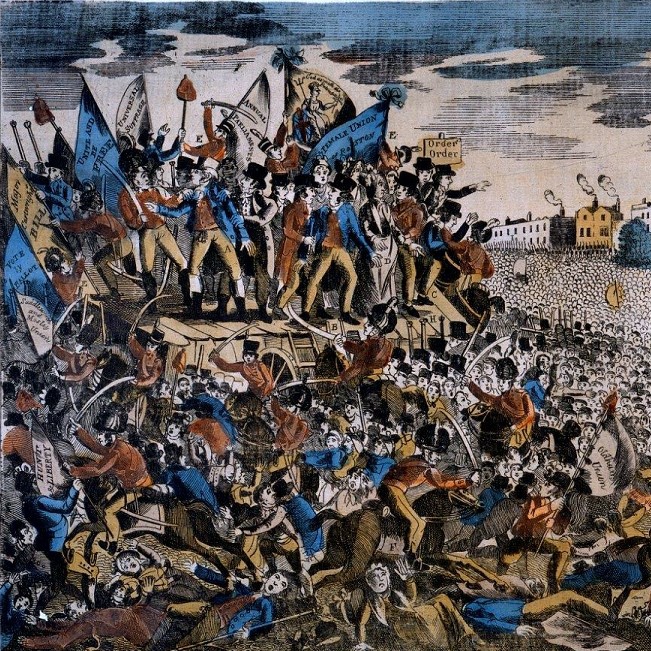203 years ago today, 60,000 working-class men and women from across the Northwest of England assembled in St Peters Field, Manchester to demand the right to vote. Back then, only 3% of the British population were on the electoral register.
Manchester, despite its vast population, hadn’t a single MP. Trade Unions were already widespread but illegal and were frequently suppressed violently.
The protesters at St Peters Field made every effort to demonstrate their peaceful intent, abandoning their walking sticks to emphasise they were unarmed, travelling in neighbourly and family groups, with the leaders of each group of travellers wearing a sprig of laurel as a symbol of peace.
An eyewitness account of the scene on arriving at St. Peter’s Field describes “large bodies of men and women with bands playing and flags and banners…There were crowds of people in all directions, full of humour, laughing and shouting and making fun. It seemed to be a gala day with the country people, who were mostly dressed in their best and brought with them their wives.”
All were eagerly awaiting the day’s main speaker, the famous reformist campaigner Henry Hunt. The atmosphere that morning would be immediately familiar to any trade unionist or socialist today, reminiscent of the Durham Miners gala or May Day celebrations.
While the Field filled with more and more people, the Magistrates of Manchester watched from an overlooking building. After observing for two hours, they decided that the peaceful meeting was to be broken up and the reform movement leaders, such as Henry Hunt, Mary Fildes and Samuel Bamford, arrested.
The Riot Act was read out my the Magistrates but was not heard by any of the crowd or the speakers. Then the Manchester and Salford Yeomanry, a militia mounted on horseback, were ordered to disperse the crowd, supported by the regular infantry and the magistrates’ own constables. The yeomanry charged the tightly packed crowd, attacking indiscriminately with their sabres. They engaged enthusiastically with their unarmed ‘enemies’, destroying their flags and banners, attacking the injured and fallen, and pursuing their fleeing victims into the surrounding streets.
At least 18 people were killed, of whom three were women, and almost 700 were injured; 168 of these were women even though in numbers they comprised only 12% of those present.
The Manchester massacre involved veterans of the Battle of Waterloo on both sides, and so in the days afterwards, the radical press coined the name Peterloo, comparing the one slaughter to the other. It is vital that we remember and continue to commemorate the Peterloo massacre.
The massacre serves as a reminder of what the ruling class is prepared to do to preserve its power when it feels under threat. It reminds us that to win the rights we have, our ancestors had to fight tooth and nail against a ruthless enemy.
We must also remember that massacres like Peterloo are not isolated events, but part of a class war that has been ongoing for centuries. Neither are they consigned to the history books, for we see attacks on workers like this happening all over the world; look at the way the police have responded to recent unrest in Chile, Sri-Lanka, Sudan, or Bangladesh, to name just a handful of examples.
It may not be long before we see their like in Britain once again, as our police become more and more draconian. In fact, the ultimate lesson of Peterloo ought to be that non-violent protest and reformism is a dead-end strategy.
Peterloo demonstrates that it doesn’t matter what lengths protesters go to emphasise their peaceful intent when the ruling class has no interest in being peaceful. The Peterloo demonstrators disarmed themselves and so had no means of self-defence.
It also took a whole century for their demands for universal suffrage to finally be met with the representation of the people act in 1918.
Contrast this with what the Bolsheviks achieved in a matter of decades. The revolutionary path is the only one that leads to a permanent change towards a just, democratic, and peaceful society.
If you want to learn more about the historical context and consequences of the Peterloo Massacre, I’d recommend both Peterloo: The English uprising by Robert Poole and The Peterloo Massacre by Robert Reid. For a primary source account of the massacre, as well as much of the political context before and afterwards, Samuel Bamford’s memoir Passages in the life of a Radical is a great place to start.
Ben Perry, is a member of the YCL’s Manchester branch



